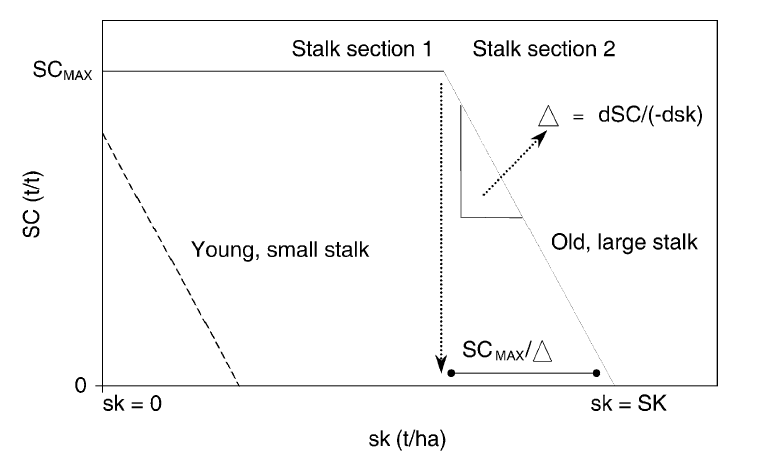The approach to model partitioning of stalk mass to sucrose is based on the source-sink concept. The rate of dry matter partitioning to stalk (ΔSK) is regarded as the source strength, and sink capacity is represented by the potential capacity of the plant to store additional sucrose to what is already accumulated. Two complementary sinks are here considered: (i) stored sucrose and (ii) fibre plus non-sucrose material (called structural mass). The equation sequence reflects the priority that structural growth enjoys over sucrose accumulation when the source is inadequate to fill both sinks to capacity:



where ΔSUC (t ha-1d-1) and ΔFNS (t ha-1d-1) are respectively stalk sucrose and structural mass increments, expressed by a fraction (a species parameter, SUCRON) of the potential structural growth or sink capacity FCAP (t ha-1). The latter is given by the difference between the actual structural mass at the start of the day (FNSin, t ha-1) and the theoretical structural mass, complementary of the theoretical sucrose mass:

where the term theoretical refers to “the maximum amount of sink machinery induced by prolonged exposure” to given (current) conditions (Minchin and Thorpe, 1996), SUCA (t t-1) is a cultivar parameter expressing the maximum sucrose content at the base of the stalk and Δ is the ripening gradient (ha t-1), representing the interaction of limiting factors (genetic, water stress and temperature):

with


where the water stress and temperature control factors are respectively FT (0, no stress; 1, fully stressed) and FW (0, hot; 1, cold); FTCON (°C-1) is the temperature response species parameter; ΔMAX (ha t-1) is a cultivar parameter representing is the maximum change in sucrose content per unit increase of stalk mass; Tmean (°C) is average daily temperature; TBFT is a cultivar temperature (°C) at which the ripening gradient of well watered cane is half of ΔMAX; SWDF2 is crop water stress for expansive growth; SWDF2AMP is an ecotype parameter expressing the sucrose partitioning sensitivity to water stress.
The graph below show the trend of the sucrose content (i.e., the ratio of sucrose to the stalk masses) as a function of the stalk mass. This “big-stalk” approach links the sucrose content estimation with the physiological age of the crop. Sucrose content in the base of sugarcane stalk is higher than the top of the stalk (i.e., the unripened section) where sucrose content decrease, influenced by genetic, water stress and temperature limiting factors.

Created with the Personal Edition of HelpNDoc: Easy EPub and documentation editor